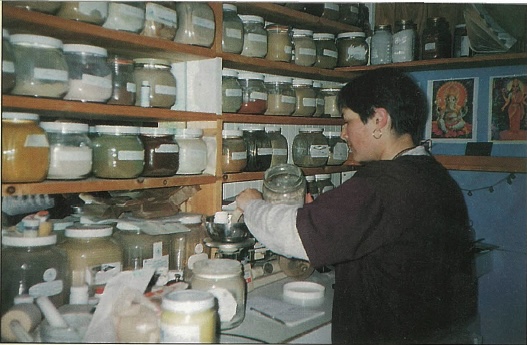Navin is a cashier in a New York bookstore. But he is no ordinary cashier. Navin (not his real name) is actually a full-qualified vaidya, an ayurvedic doctor, hailing from Gujarat. “I studied medicine for six years in India. But I cannot practice in America, and so I sell books and magazines and occasionally give free consultations,” explains Navin. His father, who lives in the US, brought him from India five years ago. “I was unemployed for more than a year before ending up here.” Because ayurveda is not a recognized form of medicine in the US, Navin cannot set up a clinic. Unable to pursue his real profession, he plans to return to India early next year.
“Navin is one of the lucky ones. At least he is able to practice a little Ayurveda,” says Swami Sada Shiva Tirtha, India-trained vaidya and founder of the Ayurveda Holistic Center in New York. “Our center receives many e-mails and calls from Indian vaidyas in the US who cannot or do not know how to begin a practice in the US. So they end up jobless or working in candy factories or stores like Navin. They are frustrated being unable to pursue their dharma.”
Ayurveda is controlled by varying requirements for unrecognized forms of healing determined by each state’s education department. Swamiji explains, “The main concern of the state is that you do not try to pretend or sound like you are a licensed allopathic medical doctor. Thus, you cannot say ‘treat,’ ‘diagnose’ or ‘prescribe,’ or call your business a ‘clinic.’ You can say ‘analyze’ or ‘suggest,’ and call your business a ‘center.’ You cannot call yourself a ‘doctor,’ but can say you are a ‘holistic educator’ or ‘guide.'”
Dr. Virendra Sodhi, who runs the Ayurveda and Naturopathic Medical Clinic in Washington State, told Hinduism Today, “I studied ayurveda for six years in college in India. But when I came to America, I had to go back to college for four more years of naturopathic medicine so I could get a license to open my clinic and be recognized as a doctor.” The advantages were substantial. “I could have practiced low-key without going to school,” explained Sodhi, “but I would be nowhere. I could not get lab tests done, or request x-rays or ultrasounds.”
Most US states have been loathe to license non-allopathic systems. But over the decades, several systems have been granted permission to be licensed when certain qualifications are met. Thus, naturopathy, homeopathy, osteopathy, chiropractic and, most recently, acupuncture, have gained legal status. In some states traditional Chinese medicine is allowed full rights.
Licensing is, at heart, a political process, and alternative systems have gained legal status more by the demands of consumers than by any openness from the allopathic establishment. Chiropractors fought for decades against orchestrated persecution from the American medical establishment. Only after lengthy court battles were they finally left to practice in peace.
Acupuncture started to gain popularity in the US in the 70s, around the same time ayurveda appeared on the American scene. As the result of intense grassroots efforts, it gained legitimate status. As of 1996, 11 states regulate the practice of acupuncture by physicians and 26 states offer licensing for nonphysician acupuncturists. Licensing allows a practitioner to open a clinic and provides qualifying services for graduates with foreign degrees. Local boards of experts are set up by the state to issue the licenses.
Ayurveda is among the newest systems to arrive in America. It is gaining popularity through efforts of people such as Deepak Chopra and organizations such as Maharishi’s Transcendental Meditation. As yet, it lacks the public support necessary to establish a licensing procedure, but that should change in just the next few years
AYURVEDA HOLISTIC CENTER, 82A BAYVILLE AVE., BAYVILLE, NEW YORK 11709. e-mail:mail@ayurvedahc.com
COPIOUS COMPENDIUM
You could buy a half-dozen plus books on ayurveda to start your reference library, or you could buy Swami Sada Shiva Tirthaâs nearly-two-kilos, 686-page Ayurveda Encyclopedia: Natural Secrets to Healing, Prevention, & Longevity. Itâs detailed enough for the professional, but accessible to the lay person. Topics include physiology and philosophy, nutrition, herbology, hatha yoga and related therapies such as by aroma, gems and music, mostly written in non-technical terms. It includes a resource list, glossary, extensive biography and descriptions of 85 major herbs. There are interesting sections on ayurvedaâs history, ethics and on how doctors should deal with patients. It is useful and entertaining for any student of ayurveda or as a home self-healing resource.
AYURVEDA HOLISTIC CENTER PRESS 82A BAYVILLE AVENUE BAYVILLE, NEW YORK 11709
